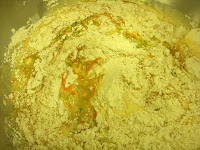Day 2, Thursday
10.30.2008
Pumpkin and Zucchini Walnut Muffins
Today we made Muffins using two different methods of production, the Muffin Creaming Method and the Well Method. Within the category of Quickbreads is biscuit method we learned yesterday, and the muffin method. The muffin method you use depends on the fat you are using, if you have solid fat then you will use the creaming method and if you use oil you use the well method.
Creaming should be done when you have solid fat and you proceed to cream that with the sugars and slowly add eggs. There is a lot of liquid in the recipe, too much to make an emulsion; therefore you should alternate liquid and dry mixes. Starting with half of the flour, fold gently, then half of the liquid, folding again, flour, fold, liquid, and fold. The disadvantage to doing this would be over mixing and working the gluten too much. The problem of tunneling can occur if you mix the gluten too much getting air bubbles. These bubbles get trapped and rise when baking, causing a visible tunnel in the muffin. It is best to mix slowly by hand.
The well method uses liquid fats, such as oils, when you can’t use the creaming method. You combine the dry ingredients, make a well in the center of your bowl, and pour in the mixed wet ingredients and mix. This makes for a softer muffin where creaming makes them cakier. Most cakes won’t have as much liquids as muffins do and have a crumbly texture where muffins can have an almost bread like consistency.
Original recipe pg. 419 of Friberg
.5 lb butter
6.5 oz light brown sugar
2 eggs
86 g molasses
85 g honey
2.5 g salt
1 g ground ginger
¾ g cinnamon
1 g allspice
.5 g nutmeg
6 g baking powder
6 g baking soda
1 lb bread flour
112.5 oz raisins
2.5 ml vanilla
180 ml buttermilk
180 ml pumpkin puree
Using these hygroscopic sugars will keep the muffin moist because they absorb moisture and hold it in. Scrape the containers well so all liquids are out, being off by a tablespoon could throw the recipe off. Periodically scrape the mixing bowl to ensure the sides and bottom are fully incorporated. When it gets to a nice smooth consistency, move up to speed 2.
Cream until it is light and fluffy. It will look paler and soft.
At this point slowly add the whisked eggs, at first this will break down the emulsion but it will come back together. Add the vanilla; extracts are an easy thing to forget so by adding it now you don’t have a chance to forget. Because there is a lot of hygroscopic sugar there is less of a chance of the emulsion splitting. If the butter is too soft the creaming won’t incorporate air and you won’t get a fluffy emulsion. In a separate bowl mix the buttermilk and puree.
Break up the lumps of pumpkin by mixing the two with the whisk. If the batter looks like it is splitting a little you can move it up to speed 3 until it comes back together. You are looking for a creamy batter that is like light brown sugar in color. The warmer the temperature of your butter and eggs the stronger emulsion you will have; if the butter is cold it will not cream well.
Add half of the flour; mix by hand fold the batter by scraping the bowl and cutting in toward the middle. Add half of the liquid and fold. You generally don’t work the gluten as much if you alternate because you are gradually adding the ingredients and in turn need to mix less.
Add the rest of the flour. Take your time in mixing; you don’t need to do it quickly, more delicately through this stage.
You can add your raisins at the end; if you toss them with the flour it tends to get caught in the small grooves on the fruit and you get an off taste when baked.
Use the #20 scoop making each slightly heaped so when it bakes a small crown forms on top. The recipe yields between 12 and 16 muffins.
Pumpkin muffins bake at 375 degrees F for around 35 minutes. It is a good idea to set the time for 20 minutes and check to see how they are coming along.
Zucchini, Carrot, and Walnut Muffins – Half recipe made in class
Original recipe pg. 421 of Friberg
4 eggs
14 oz sugar
10 oz grated zucchini
5 oz peeled carrots
1 cp vegetable oil
½ tsp salt
14 oz bread flour
2 tsp baking powder
½ T baking soda
½ T cinnamon
1 t allspice
½ t nutmeg
4 oz wheat bran
5 oz chopped walnuts
All of the dry ingredients; flour, spices, salt, and leaveners, are sifted onto parchment and put into a mixing bowl.
With both of the baked muffins you are looking for an open and tender crumb, not very dense. The color should be golden brown throughout and nothing should be burned. Pastry flour can be substituted for bread flour possibly resulting in a better product. Tunneling occurs more when bread flour is used, using the pastry might help alleviate this problem.
It is best to store the baked muffin at room temperature in canvas or a paper bag, keeping it in plastic will make it soggy. If you are going to freeze them make sure they are wrapped completely and thaw them with the plastic on to retain the moisture.





























No comments:
Post a Comment